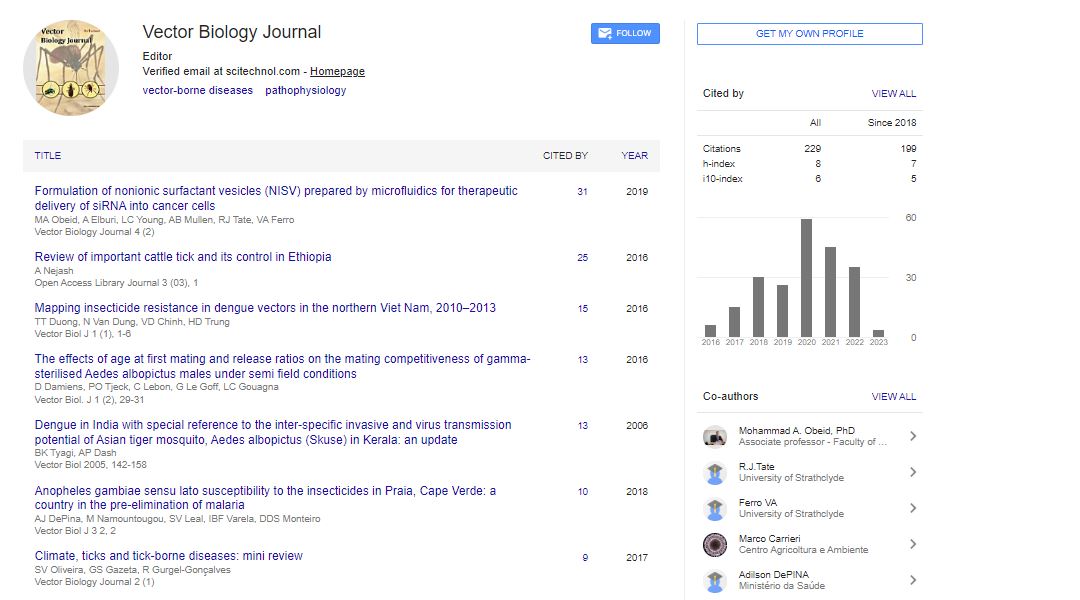Commentary, Vector Biol J Vol: 8 Issue: 4
Control and Management of Infectious Disease Outbreaks and its Assessment
Denise Karchu*
1Department of Infectious Diseases, University Medical Center Hamburg- Eppendorf, Hamburg, Germany
*Corresponding Author: Denise Karchu,
Department of Infectious Diseases, University Medical Center Hamburg-
Eppendorf, Hamburg, Germany
E-mail: karc.den@gmail.com
Received date: 21 November, 2023, Manuscript No. VBJ-24-127996;
Editor assigned date: 23 November, 2023, PreQC No. VBJ-24-127996 (PQ);
Reviewed date: 07 December, 2023, QC No. VBJ-24-127996;
Revised date: 15 December, 2023, Manuscript No. VBJ-24-127996 (R);
Published date: 22 December, 2023, DOI: 10.4172/2473-4810.1000281.
Citation: Karchu D (2023) Control and Management of Infectious Disease Outbreaks and its Assessment. Vector Biol J 8:4.
Description
Infectious diseases represent a significant global health challenge, causing millions of illnesses, deaths, and economic difficulties every year. These diseases are caused by pathogenic microorganisms such as bacteria, viruses, parasites, and fungi and they can be transmitted from person to person, through animals, or environmental sources.
Causes of infectious diseases
Infectious diseases can be caused by various types of pathogens, each with unique characteristics and modes of transmission. These pathogens include: Bacterial infections such as tuberculosis, pneumonia, cholera, and urinary tract infections are caused by pathogenic bacteria. Bacteria can multiply immediately in the body and produce toxins that cause tissue damage and inflammation. Viral infections such as influenza, HIV/AIDS, COVID-19, and hepatitis are caused by viruses, which are microscopic infectious agents that require host cells to replicate. Viruses can cause a wide range of symptoms, from mild respiratory symptoms to severe systemic illness. Parasitic infections such as malaria, leishmaniasis, schistosomiasis, and intestinal worms are caused by parasites that live and reproduce within the host organism. Parasites can be transmitted through contaminated food or water, insect vectors, or direct contact with infected individuals. Fungal infections such as candidiasis, aspergillosis, and ringworm are caused by pathogenic fungi that can infect the skin, mucous membranes, or internal organs. Fungal infections can be opportunistic, occurring in immuno-compromised individuals, or endemic, occurring in specific geographic regions.
Transmission of infectious diseases
The transmission of infectious diseases occurs through various directions, including: Direct contact infectious agents can be transmitted from person to person through direct contact with infected bodily fluids, skin lesions, or mucous membranes. Examples include respiratory infections, and skin-to-skin contact diseases. Indirect contact pathogens can be transmitted indirectly through contact with contaminated surfaces, objects, or food. Fomite transmission, where pathogens are transferred from contaminated surfaces to susceptible individuals, it is common for gastrointestinal infections and respiratory viruses. Some infectious diseases are transmitted through the air or respiratory droplets or aerosols produced when an infected person coughs, sneezes. An airborne disease includes influenza, tuberculosis, measles, and COVID-19. Vector-borne diseases are transmitted to humans through the bites of arthropod vectors such as mosquitoes, ticks, flies, and fleas. Examples include malaria, dengue fever, Lyme disease, and Zika virus infection.
Prevention of infectious diseases
Preventing the transmission of infectious diseases requires a multifaceted method that includes: Vaccines are one of the most effective tools for preventing infectious diseases by stimulating the immune system to produce antibodies against specific pathogens. Routine vaccination programs have led to the eradication or control of many infectious diseases, including smallpox, polio, and measles. Environmental sanitation maintaining clean and hygienic living conditions, including safe drinking water, proper waste disposal, and adequate sanitation facilities, can reduce the transmission of waterborne and fecal-oral diseases. Vector controlling populations through measures such as insecticide-treated bed nets, indoor residual spraying, larval source reduction, and environmental management can help to prevent vector-borne diseases. Antimicrobial stewardship is responsible use of antimicrobial agents, including antibiotics, antivirals, and antifungals, it is essential to prevent the development of antimicrobial resistance and preserve the effectiveness of existing treatments.
Control and management of infectious disease outbreaks
Infectious disease outbreaks require immediate and coordinated responses to control transmission and minimize the impact on public health. Important methods for controlling outbreaks include:
Surveillance and monitoring: Early detection and monitoring of infectious disease outbreaks through surveillance systems allow public health authorities to track disease trends, identify hotspots, and implement targeted interventions.
Case identification and isolation: Immediate identification and isolation of infected individuals, along with contact tracing and quarantine measures for exposed individuals, can help to prevent further transmission within the community.
 Spanish
Spanish  Chinese
Chinese  Russian
Russian  German
German  French
French  Japanese
Japanese  Portuguese
Portuguese  Hindi
Hindi 